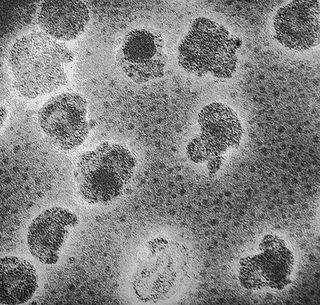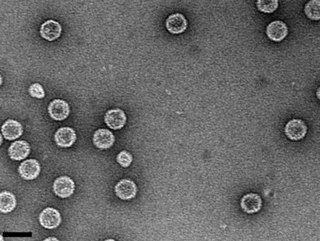Virus classification is the process of naming viruses and placing them into a taxonomic system similar to the classification systems used for cellular organisms.

Parvoviruses are a family of animal viruses that constitute the family Parvoviridae. They have linear, single-stranded DNA (ssDNA) genomes that typically contain two genes encoding for a replication initiator protein, called NS1, and the protein the viral capsid is made of. The coding portion of the genome is flanked by telomeres at each end that form into hairpin loops that are important during replication. Parvovirus virions are small compared to most viruses, at 23–28 nanometers in diameter, and contain the genome enclosed in an icosahedral capsid that has a rugged surface.

The genus Marburgvirus is the taxonomic home of Marburg marburgvirus, whose members are the two known marburgviruses, Marburg virus (MARV) and Ravn virus (RAVV). Both viruses cause Marburg virus disease in humans and nonhuman primates, a form of viral hemorrhagic fever. Both are select agents, World Health Organization Risk Group 4 Pathogens, National Institutes of Health/National Institute of Allergy and Infectious Diseases Category A Priority Pathogens, Centers for Disease Control and Prevention Category A Bioterrorism Agents, and are listed as Biological Agents for Export Control by the Australia Group.

Geminiviridae is a family of plant viruses that encode their genetic information on a circular genome of single-stranded (ss) DNA. There are 520 species in this family, assigned to 14 genera. Diseases associated with this family include: bright yellow mosaic, yellow mosaic, yellow mottle, leaf curling, stunting, streaks, reduced yields. They have single-stranded circular DNA genomes encoding genes that diverge in both directions from a virion strand origin of replication. According to the Baltimore classification they are considered class II viruses. It is the largest known family of single stranded DNA viruses.
Metaviridae is a family of viruses which exist as Ty3-gypsy LTR retrotransposons in a eukaryotic host's genome. They are closely related to retroviruses: members of the family Metaviridae share many genomic elements with retroviruses, including length, organization, and genes themselves. This includes genes that encode reverse transcriptase, integrase, and capsid proteins. The reverse transcriptase and integrase proteins are needed for the retrotransposon activity of the virus. In some cases, virus-like particles can be formed from capsid proteins.

Orthohepevirus is a genus of viruses assigned to the family Hepeviridae. Orthohepevirus is a fairly isolated viral genus in which the virions are characterized by round, non-enveloped and isometric capsids with a diameter of 27–34 nm. The hepatitis E virus belongs this genus as the species Orthohepevirus A

Potyviridae is a family of positive-strand RNA viruses that encompasses more than 30% of known plant viruses, many of which are of great agricultural significance. The family has 12 genera and 235 species, three of which are unassigned to a genus.

The International Committee on Taxonomy of Viruses (ICTV) authorizes and organizes the taxonomic classification of and the nomenclature for viruses. The ICTV develops a universal taxonomic scheme for viruses, and thus has the means to appropriately describe, name, and classify every virus taxon. The members of the International Committee on Taxonomy of Viruses are considered expert virologists. The ICTV was formed from and is governed by the Virology Division of the International Union of Microbiological Societies. Detailed work, such as identifying new taxa and delimiting the boundaries of species, genera, families, etc. typically is performed by study groups of experts in the families.

Plasmaviridae is a family of bacteria-infecting viruses. Acholeplasma species serve as natural hosts. There is one genus in the family, Plasmavirus, which contains one species: Acholeplasma virus L2. All viruses known in this family have been isolated from species in the class Mollicutes.
Hypovirus is a genus of viruses, in the family Hypoviridae. Fungi serve as natural hosts. There are four species in this genus. Infection reduces the virulence of its parasitic host, making it a hyperparasite useful for blight control.

Picobirnavirus is a genus of double-stranded RNA viruses. It is the only genus in the family Picobirnaviridae. Although amniotes, especially mammals, were thought to serve as hosts, it has been recently suggested that these viruses might infect bacteria and possibly some other invertebrates. If they do infect bacteria, then they are Bacteriophages. There are three species in this genus. Associated symptoms include gastroenteritis in animals and humans, though the disease association is unclear.
Brazilian hemorrhagic fever (BzHF) is an infectious disease caused by Brazilian mammarenavirus, an arenavirus. Brazilian mammarenavirus is one of the arenaviruses from South America to cause hemorrhagic fever. It shares a common progenitor with Argentinian mammarenavirus, Machupo mammarenavirus, Tacaribe mammarenavirus, and Guanarito mammarenavirus. It is an enveloped RNA virus and is highly infectious and lethal. Very little is known about this disease, but it is thought to be transmitted by the excreta of rodents. This virus has also been implicated as a means for bioterrorism, as it can be spread through aerosols.

Betacoronavirus 1 is a species of coronavirus which infects humans and cattle. The infecting virus is an enveloped, positive-sense, single-stranded RNA virus and is a member of the genus Betacoronavirus and subgenus Embecovirus. Like other embecoviruses, it has an additional shorter spike-like surface protein called hemagglutinin esterase (HE) as well as the larger coronavirus spike protein.
Yingvirus is a genus of negative-strand RNA viruses which infect invertebrates. Member viruses have bisegmented genomes. It is the only genus in the family Qinviridae, which is the only family in Muvirales, which is the only order in Chunqiuviricetes. There are eight species in the genus.

Peribunyaviridae is a family of viruses in the order Bunyavirales. Its name partially derives from Bunyamwera, Uganda, where the founding species was first isolated.
Gorilline gammaherpesvirus 1 (GoHV-1), commonly known as herpesvirus gorilla is a species of virus in the genus Lymphocryptovirus, subfamily Gammaherpesvirinae, family Herpesviridae, and order Herpesvirales.

Redondoviruses are a family of human-associated DNA viruses. Their name derives from the inferred circular structure of the viral genome . Redondoviruses have been identified in DNA sequence based surveys of samples from humans, primarily samples from the oral cavity and upper airway.
Ovaliviridae is a family of viruses of archaea that is not assigned to any higher taxonomic ranks. The family contains a single genus, Alphaovalivirus, which contains a single species, Sulfolobus ellipsoid virus 1. The linear genome of dsDNA is 23,219 bp with 172 bp inverted terminal repeats. Sulfolobus ellipsoid virus 1 was isolated from an acidic hot spring in Laguna Fumarólica, Costa Rica; the only known host is Sulfolobus sp. A20.
Manticavirus is a genus of viruses in the subfamily Gammaherpesvirinae, in the family Herpesviridae, in the order Herpesvirales. This genus was the only genus to consist entirely of marsupial-hosted species as of the time of naming, hence the name component Mantica, in reference to the marsupial pouch.
Phascolarctid gammaherpesvirus 1 (PhaHV-1) is a species of virus in the genus Manticavirus, subfamily Gammaherpesvirinae, family Herpesviridae, and order Herpesvirales.











